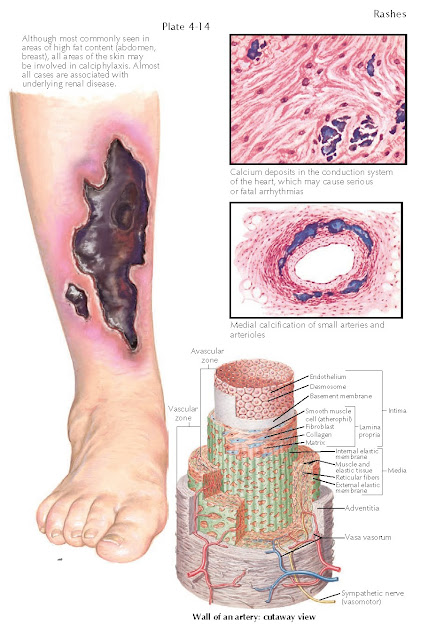CALCIPHYLAXIS
Calciphylaxis (calcific uremic arteriolopathy) results from deposition of
calcium in the tunica media portion of the small vessel walls in association
with proliferation of the intimal layer of endothelial cells. It is almost
always associated with end-stage renal disease, especially in patients
undergoing chronic dialysis (either peritoneal dialysis or hemodialysis). It
has been reported to occur in up to 5% of patients who have been on dialysis
for longer than 1 year. Calciphylaxis typically manifests as nonhealing skin
ulcers located in adiposerich areas of the trunk and thighs, but the lesions
can occur anywhere. They are believed to be caused by an abnormal ratio of
calcium and phosphorus, which leads to the abnormal deposition within the
tunica media of small blood vessels. This eventually results in thrombosis and
ulceration of the overlying skin. Calciphylaxis has a poor prognosis, and there
are few well-studied therapies.
Clinical Findings: Calciphylaxis is almost exclusively
seen in patients with chronic end-stage renal disease. Most patients have been
on one form of dialysis for at least 1 year by the time of presentation. The
initial presenting sign is that of a tender, dusky red to purple macule that
quickly ulcerates. The ulcerations have a ragged border and a thick black
necrotic eschar. The ulcers tend to increase in size, and new areas appear
before older ulcers have any opportunity to heal. Ulcerations begin proximally
and tend to follow the path of the underlying affected blood vessel. Their most
prominent location is within the adipose-rich areas of the trunk and thighs,
especially the abdomen and mammary regions. Patients often report that
ulcerations form in areas of trauma. The main differential diagnosis is between
an infectious cause and calciphylaxis. Skin biopsies and cultures can be
performed to differentiate the two. Skin biopsies are diagnostic. Radiographs
of the region often show calcification of the small vessels, and this can be
used to support the diagnosis. Patients who develop calciphylaxis have a poor
prognosis, with the mortality rate reaching 80% in some series. For some
unknown reason, those with truncal disease tend to survive longer than those
with distal extremity disease. Complications caused by the chronic severe
ulcerations (e.g., infection, sepsis) are the main cause of mortality.
Laboratory findings
often show an elevated calcium × phosphorus product. A calcium × phosphorus
product greater than 70 mg2/dL2 appears to be an independent risk factor for
development of calciphylaxis. Other risk factors are obesity,
hyperparathyroidism, diabetes, and the use of warfarin. Elevated parathyroid
hormone (PTH) levels are often found in association with calciphylaxis. The
exact role that PTH plays is unknown, but it has been reported that
parathyroidectomy, a standard treatment for calciphylaxis in the past, is not
an effective means of therapy. PTH may play a role in starting the disease, but
it does not appear to be necessary to exacerbate or cause continuation of
calciphylaxis.
Pathogenesis: The exact mechanism of calcification of the
tunica media of blood vessels in calciphylaxis is not completely understood.
The fact that it is seen almost exclusively in patients undergoing chronic
dialysis therapy has led to many theories on its origin. The final mechanism is
a hardening of the vessel wall with calcification and intimal endothelial
proliferation that leads to rapid and successive thrombosis and necrosis.
Histology: The main finding is of calcification of the
medial section of the small blood vessels in and around the area of
involvement. Thrombi within the vessel lumen are often observed. Intimal layer
endo- thelial proliferation is prominent. The abnormal calcification can easily
be seen on hematoxylin and eosin staining.
Treatment: No good therapy exists for calciphylaxis.
Aggressive supportive care and early treatment of superinfections are critical.
Surgical debridement of wounds is necessary to remove necrotic tissue that
provides a portal for infection. Renal transplantation offers some hope for
cure. Treatment with sodium thiosulfate has shown success in some anecdotal
reports, but this is not a universal cure. The newer bisphosphonate medications
have also been used with limited success. Parathyroidectomy may help initially
with the ulcerations, but it does not decrease mortality.





